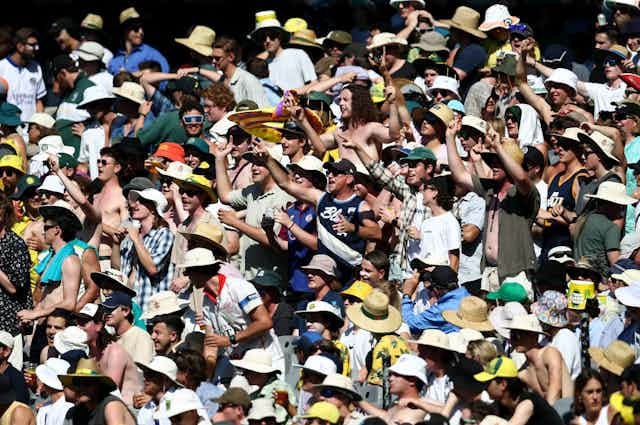As the old year passes and a new one arrives, three notable sport events occupy the languid vacation hours. Melbourne’s Boxing Day and Sydney’s New Year’s Test matches are spliced by the Sydney to Hobart Yacht Race.
Unlike the race, a set-piece seasonal spectacle notable mainly for its Rolex-sponsored affluence, picturesque helicopter shots, and (seemingly) AI-generated reporting, the cricket stirs strong emotions.
Many people are seduced by the nostalgic notion that no Australian summer is complete without two metropolitan Test matches played on green fields. Much of the experience involves half-watched television and part-heard radio broadcasts.
But anyone who messes with these national treasures risks accusations of the greatest national sin – being un-Australian.
Adored matches with short histories
Like many “traditions”, the Boxing Day Test at the Melbourne Cricket Ground (MCG) is quite recent – in fact, barely 40 years old.
It is the product of jet travel, global year-round tour schedules and, especially, the needs of commercial television.
Kerry Packer grasped the lucrative potential of large, captive audiences on vacation. Acquiring the broadcast rights in 1979, he set about maximising their value for Channel Nine. Before then, Boxing Day Tests in Melbourne were intermittent, with three in the 1970s even being staged in Adelaide.

Fairly regular Tests at the Sydney Cricket Ground (SCG) in January and February began in the late 1960s, but it was not until the late 1990s that they settled on the first week of the year. Patriotic television advertisements substantially created this misleading picture of time-honoured festive cricket rituals.
An evolving game with a crowded calendar
In the midst of this orgy of cricketing nostalgia and overindulgence of food and liquid, purists find the mounting threats to the five-day format unpalatable.
It is hard to imagine today that one-day cricket was once regarded as the “fast food” version of the game.
But that was before we got the memo from, in particular, the men’s and women’s Indian Premier League.
Here, players are literally bought and sold in a sporting meat market, along with megabuck franchises. Cricket contests are shrunk to 20-over “big bashes” of barely three hours’ duration, the senses bombarded with music, dance, programmed crowd stimulation and loud advertisements.
This Twenty20 form of the game has mushroomed around the world, including in the sportswashing capitals of the Middle East. It has been joined recently by a newer, fast-paced variation called The Hundred to compete with the slower, longer one-day and Test forms of the game.
After more than a century in the Olympic wilderness, cricket is also returning to the fold at the 2028 Los Angeles Games, courtesy of some heavy lobbying by India. It may well feature at the 2032 Brisbane Games, where its famous venue, the Gabba, will be rebuilt.
Consequently, the global cricket calendar is becoming even more congested. A clear case is the Twenty20 series that took place in India within four days of the month-long men’s 2023 World Cup.
The teams that played in the one-day final, Australia and India, faced off again in the Twenty20. But half the Australian team returned home, and only one of the Indian one-day team participated.
Such time pressures and competition variations encourage more players and coaches to specialise in different cricket formats. The money is comparatively easy in the short form of the game, while the physical and mental health toll can be reduced by opting out of Test and even one-day cricket altogether.
Suffering in the name of tradition
The Australian cricketers who do play in future Melbourne and Sydney Tests may find they will move west to Adelaide or Perth, or north to Brisbane. As Cricket Australia goes to tender for its new seven-year broadcast contract, it has made clear that no venue has a guaranteed Test match.
Of course, such matters are being raised in a play for more cash. But with expensive new stadia to fill and state governments offering juicy inducements to snag a prestigious Test match, Australia’s two largest cities may be dismissed on these crucial days.

There is also the problem of the frequently sodden Sydney, with agitation that the key New Year’s Test should be moved from one of the wettest cities where elite cricket is played.
To preserve the heritage value of the New Year’s Test, must bored, damp spectators sit in the stands? Or TV viewers be forced to watch images of a covered pitch and listen to droning fill-in commentary?
As the COVID pandemic lockdown showed, sports like cricket now resemble continuous-process manufacturing industries, or global just-in-time operations where the “product” is assembled via intricate logistics.
The lines between tradition and progress constantly shift in these hyper-commercial cricketing times. One casualty may be the largely illusionary sense of continuity proffered by Australia’s Boxing Day and New Year double bill.

